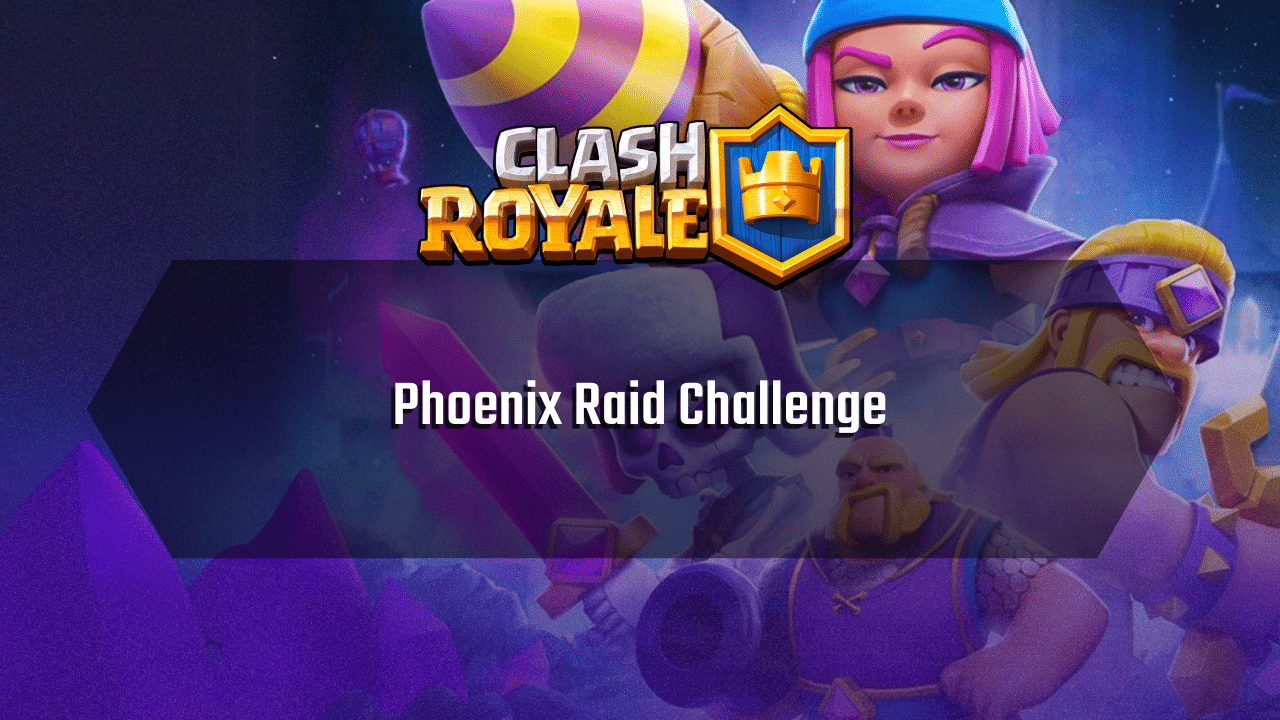
Introduction to the Phoenix Raid Event
Welcome to the Phoenix Raid event, a unique and fiery challenge within Clash Royale! This guide will provide you with the essential information and strategies needed to navigate the Clash Royale Phoenix Raid Challenge successfully.
What is the Phoenix Raid Event?
The Phoenix Raid event is a 1v1 battle format where both you and your opponent will face a constant influx of Phoenix cards that spawn automatically during the match. Unlike standard battles, you do not deploy these legendary birds; they appear on their own to create a dynamic and often chaotic battlefield. To emerge victorious, you must adapt your deck-building and tactics to effectively counter these airborne threats and leverage the Phoenixes that appear on your side. Players must carefully balance their use of elixir and deployment strategies, as the Phoenixes automatically spawn without consuming any resources.
Event Duration
The Phoenix Raid event took place during Season 65 of Clash Royale, running from 11 November to 18 November 2024.
Event Mechanics
The way Phoenixes spawn evolves as the match progresses through the elixir stages:
In the Single Elixir (first 3 minutes), one Phoenix will spawn periodically beside each player’s King Tower. The very first Phoenix for both players will appear after 10 seconds, at the 2:50 mark of the game. Subsequent Phoenix spawn timings are as follows:
2:50 – 1 Phoenix
2:35 – 1 Phoenix
2:20 – 1 Phoenix
2:05 – 1 Phoenix
1:50 – 1 Phoenix
1:35 – 1 Phoenix
1:20 – 1 Phoenix
1:05 – 1 Phoenix
0:50 – 2 Phoenixes
0:35 – 2 Phoenixes
0:20 – 2 Phoenixes
0:05 – 2 Phoenixes
Once the game reaches double elixir, the intensity increases with two Phoenixes spawning simultaneously on each side of the King Tower.
It is crucial to understand that these automatically spawned Phoenixes act as regular troops on the lane where they appear, heading towards the opponent’s towers and engaging any enemy units they encounter. Importantly, these spawned Phoenixes do not cost any elixir to deploy, making it essential to manage your resources wisely to handle both Phoenixes and your regular cards effectively.
Goal
This guide aims to equip you with the knowledge and strategies to excel in the Phoenix Raid event. We will explore effective deck compositions, provide essential tips for both offensive and defensive play, and highlight key considerations for navigating this unique challenge. Since Phoenixes spawn automatically, your deck needs to handle both offensive and defensive pressure efficiently. Understanding when to play your cards and managing elixir becomes even more critical as Phoenixes multiply during the match.
By understanding the Phoenix’s role in this event and implementing the guidance provided, you’ll be well-prepared to secure victories and make the most of your Phoenix Raid battles. Whether focusing on utilizing the Phoenixes as a free resource or deploying your own high-impact cards to counter the opponent’s Phoenixes, strategic thinking and deck adjustments are key to mastering this fiery event.
Understanding the Phoenix in the Event
In the Phoenix Raid event, the Phoenix card plays a central and unique role due to its automatic deployment. Understanding how these fiery birds function within the specific rules of this challenge is essential for developing effective strategies.
The Phoenix spawns automatically for both players, making it different from regular battles where you manually deploy troops. This means that you do not spend any elixir to have the Phoenixes appear on the battlefield. The Phoenixes always appear beside each player’s King Tower. During the single elixir phase (the first three minutes), one Phoenix spawns periodically for each player. The first Phoenix appears 10 seconds into the match at the 2:50 mark, with subsequent spawns occurring every 15 seconds until the 0:05 mark, when two Phoenixes spawn at once. As the game progresses into the double elixir phase, the intensity increases, and two Phoenixes spawn simultaneously on each side of the King Tower.
Once a Phoenix is spawned, it acts as a regular troop and will automatically move down the lane in which it appears, engaging any opposing ground or air units it encounters. This makes the Phoenix a persistent threat during the battle. Additionally, it does not cost any elixir for either player to deploy, so careful elixir management is necessary for other deck cards.
The Phoenix is a high-damage troop with impressive damage per second (DPS), making it a serious threat to both troops and towers if left unchecked. Allowing an opponent’s Phoenix to reach your Crown Towers can result in significant damage, potentially turning the tide of the game in their favor. However, despite its offensive power, the Phoenix has vulnerabilities. It can be easily countered by various troops and spells, requiring strategic planning to neutralize its threat.
Since you cannot control when the Phoenixes spawn, your strategy must revolve around supporting the Phoenixes that spawn on your side to maximize their effectiveness, while also efficiently defending against the Phoenixes that spawn for your opponent. In this event, the Phoenix card is banned from being included in player-built decks, meaning your strategy will focus on countering the automatically spawning Phoenixes with the remaining eight cards in your deck.
Effective deck-building and gameplay strategies are key to excelling in this unique event, where the Phoenixes can dramatically influence the flow of the match.
General Winning Strategies and Tips
Succeeding in the Phoenix Raid event requires a shift in mindset due to the constant presence of Phoenixes on the battlefield. The Phoenixes are automatically spawned by the game and do not cost elixir, but managing the rest of your deck and using them effectively is key. One important strategy is to support your own Phoenixes. Since they spawn on your side, deploying troops to back them up can increase the chances of reaching the opponent’s towers and dealing significant damage. Timing your attacks and pushes to coincide with the arrival of your Phoenixes will allow you to apply pressure on your opponent.
On the other hand, defending against the opponent’s Phoenixes is just as critical. If left unchecked, their high damage per second (DPS) can cause major damage to your towers. Use your troops and spells to eliminate or distract incoming Phoenixes, ensuring they do not reach your Crown Towers. Be aware of Phoenix spawn timings, and plan your attacks around them. By anticipating when an additional Phoenix will spawn on your side, you can time your pushes for maximum offensive pressure. Conversely, be prepared to defend when you know the opponent’s Phoenixes will soon appear.
Effective elixir management remains crucial despite the fact that Phoenixes are free to deploy. You still need to manage your elixir wisely for the rest of your deck. Avoid overspending on attacks, as you will need elixir to defend against the opponent’s Phoenixes and other pushes. Utilize cheap defensive cards to maintain an elixir advantage, especially as you enter the double elixir phase when the intensity increases.
It’s also important to adapt your deck and playstyle based on the strengths and weaknesses of your cards. Understand when your deck is best suited for aggressive plays and when you need to focus more on defense. Since the Phoenix card is banned in player decks, your strategy must rely on supporting the Phoenixes that spawn on your side and countering the opponent’s Phoenixes. Some players find success by baiting out spells like Arrows, using cards like Firecracker to gain value against the Phoenixes.
Be mindful of cards commonly used in the event, such as Ram Rider, Firecracker, Arrows, and Cannon. Consider how your deck can either use these cards effectively or counter them. While Phoenixes do not lay eggs in this event, spells like Arrows are still useful for clearing out swarms and other troops that may pose a threat. Additionally, be prepared to handle other air units that may appear in your opponent’s deck. Although the Phoenix itself provides some anti-air defense, if your deck lacks dedicated air counters, consider including cards like Wizard or Musketeer. Spells such as Lightning or Void Spirit can also be effective against air units, and the Cannon can serve as a distraction in certain situations.
By deploying your troops to support your Phoenixes and ensuring you prevent the opponent’s Phoenix from reaching your Crown Tower, you can increase your chances of winning. Keep these strategies in mind and adapt to the dynamics of the Phoenix Raid event. With the right deck composition and strategic play, you can successfully navigate this unique challenge and secure victories.
Recommended Decks for the Phoenix Raid Event
Given the unique nature of the Phoenix Raid event, where Phoenixes spawn automatically for both players, deck building shifts to focus on supporting your own spawned Phoenixes and countering the ones that appear on the opponent’s side. Since the Phoenix card itself is banned from being included in player-built decks for this event, strategies must revolve around maximizing the value of other cards while managing the Phoenixes that automatically spawn during the match.
One recommended deck is the Goblinstein Ram Rider Rage Deck, which focuses on bridge spam tactics. Key cards in this deck include Evo Skeletons, Evo Firecracker, Rage, Cannon, Dart Goblin, Arrows, Ram Rider, and Goblinstein. The strategy is to apply constant pressure by cycling Ram Rider and Dart Goblin to attack the Princess Towers. Rage boosts damage output, and Evo Firecracker provides valuable splash damage, which is especially useful against groups or the Phoenix after its respawn. For defense, Evo Skeletons and Cannon can be used, while Arrows help manage swarm troops.
Another strong option is the Hog EQ Firecracker Deck, a classic Hog Rider archetype adapted for the Phoenix Raid event. With key cards like Evo Skeletons, Evo Firecracker, Ice Spirit, The Log, Cannon, Earthquake, Hog Rider, and Goblinstein, this deck provides consistent offensive pressure while maintaining strong defensive options. The low-elixir cycle allows frequent Hog Rider pushes, while Goblinstein provides a secondary win condition. Evo Firecracker works well to accumulate chip damage, and defensive cards like Ice Spirit and Evo Skeletons help manage opponent pushes. The Log and Earthquake offer control, and Cannon can defend against beatdown decks.
For players who prefer a more defensive approach, the Evo Mortar Goblinstein IWiz Deck is an excellent choice. This deck includes cards like Evo Bats, Evo Mortar, Goblin Gang, Miner, Ice Wizard, Arrows, Cannon Cart, and Goblinstein. The main goal is to build an elixir lead by prioritizing defense and handling enemy pushes. Once the opponent overcommits, the Evo Mortar can be used to deal significant tower damage. The Miner and Goblinstein provide alternative win conditions, while Cannon Cart helps eliminate mini-tanks. Goblin Gang offers high DPS, and Ice Wizard excels in crowd control. Arrows deal with swarm units, which is especially useful when managing the Phoenixes.
In addition to these recommended decks, several considerations and synergies should be kept in mind. Baiting Arrows is an effective strategy, as using cards like Firecracker can force the opponent to use their Arrows, leaving them vulnerable to the Phoenixes. Air defense is also important, as the Phoenix provides some anti-air capabilities but may not be enough to handle other flying units. Cards like Wizard and Musketeer offer strong offense but can be vulnerable to spells like Lightning and Void. Wizard’s splash damage can also help deal with multiple Phoenixes in later stages of the game.
Spells like Lightning are effective for eliminating air units such as Wizard and Musketeer, while Void (Ice Spirit) can counter cards like Firecracker and Princess. Arrows remain a popular choice for dealing with swarm troops and can be effective against Phoenixes as well. Earthquake is especially useful in Hog Rider decks, where it helps with controlling buildings and slowing down enemy troops. Additionally, Rage can be used to significantly boost the damage of your offensive units, especially when supporting your spawned Phoenixes.
Defensive buildings such as the Cannon are useful for dealing with Phoenixes and in cycle decks. Other buildings like Goblin Cage or Tesla can be considered replacements for cycle cards, particularly if you’re struggling against beatdown decks. The best deck for the Phoenix Raid event will depend on your playstyle and card levels, so experimenting with different combinations and strategies will help you find what works best for you. By focusing on these synergies and adapting to the specific challenges of the Phoenix Raid, you’ll be well-equipped to succeed in this unique event.
Popular and Banned Cards
Understanding the cards that were frequently used and those that were restricted during the Phoenix Raid event can provide valuable insights for deck building and formulating counter-strategies.
Several cards became popular choices during the Phoenix Raid event due to their synergy with the event’s mechanics or their effectiveness in dealing with the constantly spawning Phoenixes. Firecracker, including its Evolution, was a standout card. Its ability to deal splash damage made it especially effective against the Phoenix after it respawned. The evolved Firecracker further enhanced its value, providing even more powerful splash damage.
Arrows were another commonly used spell, primarily for countering swarm troops and dealing with Phoenixes. Arrows could also handle Phoenix eggs, although Phoenixes didn’t lay eggs in this event, showing the versatility of the card in clearing out multiple threats. The Cannon was frequently included in decks as a defensive building that could distract Phoenixes and other troops. It also offered a quick cycle option for players using low-elixir decks.
Ram Rider appeared in multiple recommended decks, often as a win condition. Its ability to stun enemy troops made it effective for applying constant pressure. Goblinstein, as a versatile Champion card, was also popular in many decks, both for offensive and defensive capabilities. Evo Skeletons, a cheap cycle card with defensive potential, were included in numerous decks due to their low elixir cost and effectiveness. The Hog Rider, a classic win condition, was frequently paired with Earthquake in cycle decks, offering a consistent way to deal damage to towers.
Miner was another card often used in decks, capable of chipping away at towers and targeting defensive structures, as well as protecting Phoenixes. Spells like Lightning and Void (likely referring to Ice Spirit) were utilized for their ability to deal with air units such as Wizard and Musketeer, which could also appear in opponent decks. Lightning delivered substantial damage to air troops, while Void (Ice Spirit) provided utility by disrupting key support units. Wizard and Musketeer, although vulnerable to spells, were considered by some players for their ability to target air units. Wizard’s splash damage proved useful for dealing with multiple Phoenixes on the battlefield.
A significant restriction in the Phoenix Raid event was the banning of the Phoenix card from player-built decks. This meant that players could not include Phoenix in their decks and had to develop strategies to counter the automatically spawning Phoenixes using their eight chosen cards. This added a unique challenge to the event, as players had to adapt their tactics to deal with the Phoenixes without having access to this powerful card.
Understanding these popular and banned cards provides a clearer picture of the Phoenix Raid event’s meta and can guide deck building and gameplay decisions. Players could use this knowledge to plan their strategies more effectively, especially if the event were to return in the future.
Conclusion
The Phoenix Raid event in Clash Royale introduced a unique challenge where players had to adapt their deck-building and gameplay strategies to the constant presence of automatically spawning Phoenixes, all while being unable to include the Phoenix card itself in their decks. This created a distinct meta, requiring players to focus on supporting their own Phoenixes while countering the relentless fiery onslaught from their opponent’s side.
Key to success in this event was understanding the timing of Phoenix spawns and building decks that could capitalize on these free troops while defending against them. Several card archetypes and specific cards proved effective in the event. Bridge spam decks, like the Goblinstein Ram Rider Rage deck, aimed to apply constant pressure and overwhelm opponents with frequent offensive pushes. Cycle decks, such as the Hog EQ Firecracker deck, allowed for rapid card rotations, maintaining offensive pressure while using key defensive units efficiently. Defensive decks, such as the Evo Mortar Goblinstein IWiz deck, focused on building elixir advantages through solid defense before launching strategic counter-attacks.
Popular card choices often included those with splash damage, such as Evo Firecracker and Wizard, to deal with the respawning Phoenixes. Defensive buildings like the Cannon provided valuable distractions and anti-Phoenix capabilities. Spells like Arrows, Lightning, and Earthquake offered control against swarms, air units, and buildings respectively. The ban on the Phoenix card itself emphasized the event’s central mechanic, pushing players to find innovative solutions using the rest of the Clash Royale card pool.
Ultimately, mastering the Phoenix Raid event required a combination of smart deck building, understanding the event-specific mechanics, and adapting gameplay to both support your own Phoenix and neutralize your opponent’s. Experimenting with different card combinations and strategies was essential for finding a deck that suited individual playstyles and card levels. Should the Phoenix Raid event return in the future, the insights gained from this guide, particularly regarding effective card synergies and counter-strategies, will be invaluable for players aiming to succeed once again.













